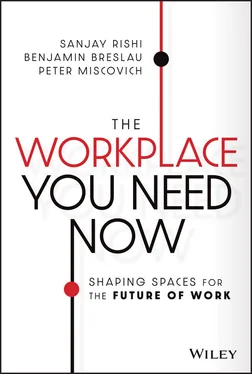In conjunction with the rise of the amenities-rich office emerged the idea that standard desks and chairs weren’t the only path to productivity. Residential-style furnishings and activity-based workspaces for different kinds of work could also be highly beneficial. WeWork helped pioneer these concepts with its coworking spaces, complete with huddle booths, open spaces, benches, private offices, meeting rooms, and a comfortable design aesthetic.
Forward-looking companies began investing in humanized workplaces with creative layouts encompassing different kinds of workspaces and seating options. These new kinds of workplaces were intended to appeal to highly skilled and sought-after employees, while providing the right kinds of workspaces for collaboration, heads-down solo work, and private calls or meetings.
Only over the past decade has the idea of aligning the workplace with a company’s mission and purpose spread beyond a select few brands. For some, the effort was more superficial or experimental than substantive, limited by cost pressures and financial performance concerns.
Nonetheless, these efforts formed the important prototypes of purposeful and experiential workplace environments that elevate the office above its roots as a place to get work done. The workplace has become part of the company brand and expression of its ethos, motivating the workforce to gather and achieve a common mission. The action office has evolved to the intelligent office, supporting multidimensional work, from deep concentration to customer engagement, “showroom” activities to extended reality experiential work.
As is usually the case, the future of the workplace had arrived – but even now, it hasn’t been evenly distributed.
As workplaces have evolved – or should evolve – to more closely address the needs and preferences of employees, location has become part of the workplace strategy, too.
Over time, the location preferences for corporate offices have shifted, depending on the value equation, or the balance between the cost of real estate and the opportunities of a location in terms of the quality of the space, convenience, safety, and proximity to talent, customers, and jobs.
In the United States, for example, central business districts (CBDs) were the growing focus for decades as the centers of commerce and industry. Yet, many US urban areas lacked vibrancy and were perceived as challenged by crime and lack of cleanliness.
By 1960, the interstate system had opened the suburbs to urban workers, allowing them easy access to affordable and spacious housing, green space, and safety. Suburbia created a compelling value proposition for aspiring families throughout the 1970s and 1980s. Employers soon followed, establishing campus settings within easy drives to convenient suburban locations, often near highway interchanges.
The preference for the suburbs persisted until the 1990s and 2000s, when enterprising mayors and civic organizations revitalized urban areas with 24/7 amenities and a greater sense of safety. Cities once again became attractive to residents and employees, especially younger generations looking for a dynamic urban “vibe,” cultural amenities, the convenience of public transportation, and a compact, high-density, live-work-play environment.
Employers were quick to follow employees back to the urban environment, as evidenced by the rush of corporate campus relocations and expansions in CBD and emerging urban locations during the past 20 years. Prime examples include Google’s offices in Manhattan, GE’s location in Boston, McDonald’s downtown Chicago headquarters, and Amazon’s facilities in Seattle and Washington, DC’s near-suburb of Crystal City, Virginia. Urban areas became more dynamic and competitive, offering the best overall value for corporate employers seeking to attract the next generation of workers.
Now, the value equation is shifting again. Urban environments and big gateway cities have grown increasingly expensive, with housing costs rising more quickly than the wages of the average worker. In the pandemic environment, cities became less desirable – albeit perhaps temporarily – and the remote working option made it easier for employees to live and work far from their corporate homes.
Thanks to the combination of the natural aging of the giant millennial generation – creating new households and families – and the newfound flexibility of remote working, Sun Belt cities and suburban (or “outer urban”) environments are seeing growing popularity, at least temporarily. Sun Belt and suburban markets outperformed traditional CBDs in terms of commercial real estate rents and occupancy during the pandemic. Many of these new “growth markets” enjoy demographic tailwinds and other advantages that make it likely that they will continue to prosper. But have no doubt, the great urban gateway cities will rise and prosper once again, filled with great companies and young talent. As evidenced by population shifts from cities to suburbs and back again, future changes are likely inevitable over time.
Next-Generation Remote Working
Demographic shifts had already begun to affect workplaces well before the pandemic, with the idea of a seamless live, work, and play environment starting to take hold in varying measures. Technology companies had been praised for creating a completely different kind of workplace, with amenities, sports and fitness spaces, and collaboration spaces to attract and retain up-and-coming talent. Companies in other industries sought to adopt similar concepts, with the expectation that doing so would enable them to be equally talent-centric and driven by creativity.
However, the emergence of this new type of workplace was not without challenges. The novelty of amenities gave way to a realization that installing smoothie bars and collaboration zones was not enough to declare that a cultural shift had occurred. Early adopters outside the tech space realized that a foosball table without a broader workplace philosophy didn’t really amount to much. The culture of organizations and regions, the preferences of individuals in various geographic locations around the country and the world, and the nature of the work itself were all cited as reasons to exchange a one-size-fits-all approach to workspaces no matter how amenities-heavy – with greater alignment to the ethos and culture of each organization.
And then came the pandemic, which brought upheaval in perceptions and experiences of individuals and organizations. The rapid movement of work from offices to homes demonstrated – at times surprisingly – the vast possibilities for productive workers contributing to organizational success from more diverse workplace settings. Some have suggested the possibility of all office work being performed remotely. While the debate rages on about the various dimensions that impact the question of why organizations need an office, the idea that workplaces will disappear entirely has been convincingly dismissed. The idea that workplaces will likely need to change and evolve is also an agreed-upon truth.
As the largest work-from-home experiment since the advent of the corporate office, our recent experiences have shown that remote work can be effective – although not everyone wants to work remotely all the time. Now, some C-suite leaders are questioning how productive their remote workers have really been, how much office space their companies actually need, and what the real purpose of that space should be.
It’s important to remember that the pandemic era is not the first time that major companies have attempted remote work at scale. Previous remote-work initiatives during the 1970s through the 1990s taught many painful lessons on the shortcomings of large-scale work-from-home approaches, particularly at companies where culture was not well defined. In these experiments, organizations had at least some of the technology to accomplish large-scale remote work. Yet, many fell behind the progressive leaders that had continued to focus primarily on their physical offices as talent magnets and innovation centers. Early on, companies attempting the mixed-mode workplaces often unintentionally created an information disconnect between those in the office and remote workers, and fell behind in innovation and performance. Ultimately, some returned to requiring most employees to work in the office, whether all or at least some of the time.
Читать дальше












